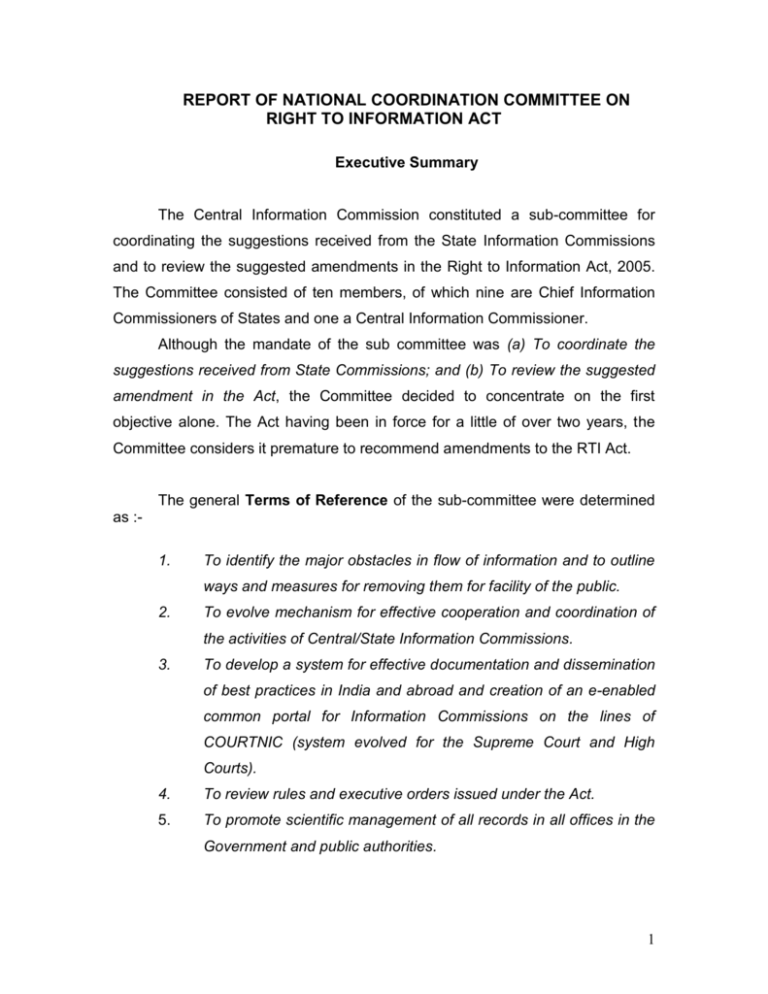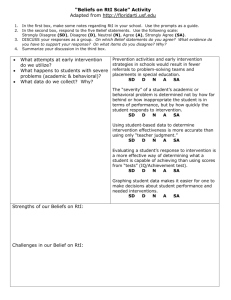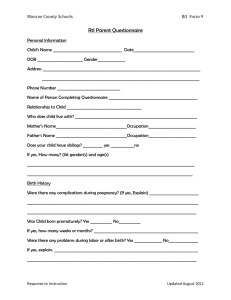Executive Summary
advertisement

REPORT OF NATIONAL COORDINATION COMMITTEE ON RIGHT TO INFORMATION ACT Executive Summary The Central Information Commission constituted a sub-committee for coordinating the suggestions received from the State Information Commissions and to review the suggested amendments in the Right to Information Act, 2005. The Committee consisted of ten members, of which nine are Chief Information Commissioners of States and one a Central Information Commissioner. Although the mandate of the sub committee was (a) To coordinate the suggestions received from State Commissions; and (b) To review the suggested amendment in the Act, the Committee decided to concentrate on the first objective alone. The Act having been in force for a little of over two years, the Committee considers it premature to recommend amendments to the RTI Act. The general Terms of Reference of the sub-committee were determined as :1. To identify the major obstacles in flow of information and to outline ways and measures for removing them for facility of the public. 2. To evolve mechanism for effective cooperation and coordination of the activities of Central/State Information Commissions. 3. To develop a system for effective documentation and dissemination of best practices in India and abroad and creation of an e-enabled common portal for Information Commissions on the lines of COURTNIC (system evolved for the Supreme Court and High Courts). 4. To review rules and executive orders issued under the Act. 5. To promote scientific management of all records in all offices in the Government and public authorities. 1 6. To promote the spread of public awareness and training as mandated by Section 26 of the RTI Act. 7. To suggest arrangements for better information delivery at the district level. Based on their practical experiences, nine State Information Commissioners represented in the Committee have given their first-hand evaluations of the problems and issues facing RTI Act at the State and District level. Additionally, some State Commissions and some State Information Commissioners have on their own made brief suggestions for consideration of the Committee. All such suggestions have been duly considered by the Committee in the context of the issues forming a part of the Terms of Reference. The Committee felt it necessary to associate with key institutions which have been working in the RTI area and assisting a variety of stakeholders in developing capacities for effective implementation of the RTI Act. The Committee decided to use the services of the Centre for Good Governance (CGG), Hyderabad and Yashwantrao Chavan Academy of Development Administration (YASHADA), Pune given their reputation, expertise and experience in this area. Both these institutions are working as National Implementing Agencies under the UNDP funded & DoPT initiated `Capacity Building for Access to Information Project’. The Committee made an appraisal of key issues pertaining to each item mentioned in the Terms of Reference. The key issues and constraints identified pertain to the following: The free flow of information has been hampered by several factors. These include Institutional issues, Organisational issues, non-standradisation & non-compliance with basic processes & mechanisms, lack of awareness 2 and usage of the RTI Act, deficiencies in the role and functioning of State Information Commissions, limited use of information technology Lack of effective coordination & cooperation among State Information Commissions as there is no worthwhile system in place for various State Information Commissions to share and disseminate information, case laws and best practices in the promotion of open government. The limited use of technology has hindered the effective implementation of RTI. Except in a few states no effective IT systems have been established to monitor and report on the disposal of applications by public authorities. Likewise, internal systems for management of complaints and appeals by SICs are non-existent in many states. Each SIC has a different website and there is no uniformity across them on structure, content or templates. While most state governments have subscribed to similar rules framed by the Government of India, there are a few states which have made different rules, especially those pertaining to fees and costs. The quality of records management in public authorities is very poor. In most Government organisations, records are not organized systematically. The use of IT to strengthen records management systems have been implemented in very few government offices. Although different states have initiated training of key officials on the RTI Act, there is great variance across states in their efforts to sensitise and train various supply side stakeholders on the RTI Act. On the demand side, the fundamental issue in this regard is awareness on RTI among the general public on which limited progress has been made. The problem of delivery at the field/district level is a critical one. There is a lack of infrastructure with the public authorities at the district level which makes dissemination of information practically impossible. At the same time, the organisational and individual capacities at the cutting edge level for dealing with the RTI mandate are considerably weaker. 3 The Committee also notes the significant positive outputs that are evident since the Act came into being. This include (a) a gradual acceptance of RTI at the supply end (b) compliance on key provisions of the Act by most states (c) functional State Information Commissions (d) gradually increasing awareness and usage of the Act (e) role of the media and civil society and (f) development of specific institutional mechanisms. The Committee has made a set of 54 recommendations. The break-up of the recommendations are as given below: Terms of Reference No. of Recommendations 1. To identify the major obstacles in flow of information and to outline ways and measures for removing them for 12 Nos. facility of the public. 2. To evolve mechanism for effective cooperation and coordination of the activities of Central/State Information 6 Nos. Commissions. 3. Documentation and dissemination of best practices in India and abroad and Creation of an e-enabled common 7 Nos. portal for Information Commissions 4. To review rules and executive orders issued under the Act. 5. Scientific management of all records in all offices in the Government and public authorities. 6. The spread of public awareness and training as mandated by Section 26 of the RTI Act. 7. Information delivery at the district level. 2 Nos. 4 Nos. 14 Nos. 9 Nos. A summary of recommendations indicating action to be taken by Governments institutions etc. with regard to each recommendation is also provided in Annexure 3. 4 The Committee hopes that there is a concerted attempt made by the Central Government and the State Governments to implement the RTI Act, 2005 in true letter and spirit. The issues raised by the sub-committee needs the immediate attention of the Government and requisite action may be taken to ensure removal of the bottlenecks and constraints hindering its effective implementation. 5



